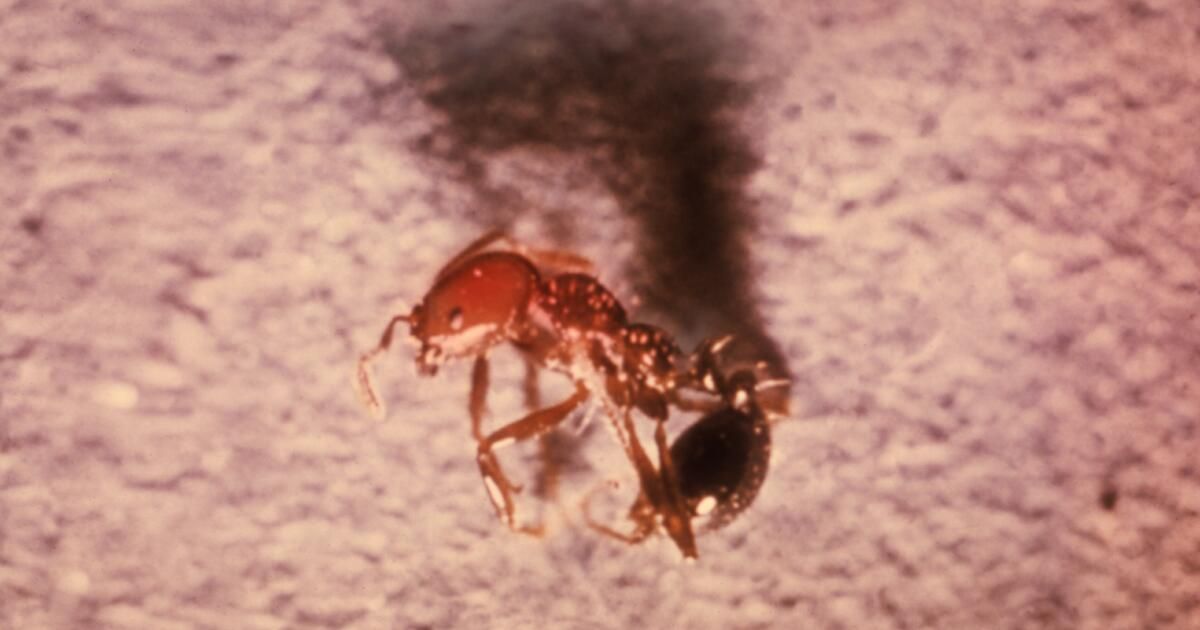A new population of “highly aggressive” imported fire ants has infested a private property in Montecito, according to Santa Barbara County officials.
Ants can bite and sting humans, pets and livestock, usually to defend their nest or colony, according to a news release from the Santa Barbara County Agricultural Commissioner’s Office. The venom from an ant’s bite can “cause painful pustules on the skin and can be particularly dangerous, even fatal, to sensitive groups or people with an allergy to the venom.”
Officials were alerted to the presence of imported fire ants on the Montecito property in 2023 and continued to monitor the site when they discovered this year that the population had infested the area.
“We believe it came from a licensed Riverside County nursery stock vendor,” said Deputy Agricultural Commissioner Stephanie Stark. “One of the ways [the red imported fire ant] spreads through contaminated or infested soil.”
Native to South America, these ants have long been a thorn in the side of pest control officials in southern states such as Texas, which spends about $1.2 billion each year trying to control ant populations. Stark said Santa Barbara County undergoes a rigorous and strict process to examine agricultural products shipped from quarantine zones that are infested with imported red fire ants.
But those measures haven’t stopped the ants from heading north. The last time Santa Barbara had to deal with this invasive species was in 2017, and the county is likely to face future episodes. To date, Santa Barbara County has spent more than $15,000 to eradicate red imported fire ants each time they appear, Stark said.
While red imported fire ants do not eat agricultural products, they “sting people and animals, threatening wildlife. They can damage electrical equipment and can also displace other native ants in an area because they can use [their venom] “Against other ants as well,” said Siavash Taravati, an entomologist and integrated pest management consultant at California Agriculture and Natural Resources University.
The invasive insect has been a nuisance to California pest control officials since they declared war on the ant in the late 1990s and early 2000s. In Riverside, where Taravati is based, the ants have such a hold that eliminating them is nearly impossible, he said. But he believes Santa Barbara County has a chance to stop their spread.
The county “only has it in one area,” said Taravati, who advises county officials on the total elimination of the red imported fire ant. “We hope to be able to eradicate it and prevent it from spreading to other parts of the county,” he said.
Inexperienced pest control workers could try pouring liquid insecticide on red imported fire ant nests, Taravati said, but it's not that simple. “If you miss a single queen, she can lay more eggs later and then the whole problem comes back,” he said.
Red imported fire ants don't have many natural predators in Southern California, except for phorid flies. The key to killing a local colony of red imported fire ants is to use a combination of chemical concoctions and greasy baits, because the carnivorous ants love protein.
“[Foragers] “The ants feed on the bait and take it back to the nest to feed their larvae and their queen or queens in the colony,” Taravati said. “These baits are designed to be slow, because if they kill the ants super fast, there won’t be enough time to pass the toxicants or insecticides to the queen and the rest of the colony.”
It may be difficult at first to distinguish the red imported fire ant from the sugar-loving Argentine ant, but one key distinction is the aggressive nature of red imported fire ants.
Mark Hoddle, director of the Invasive Species Research Center at the University of California, Riverside, said his first encounter with red imported fire ants was in Louisiana while he was searching for a different invasive species on a citrus tree. He inadvertently stepped on a mound and was quickly swarmed by angry red imported fire ants that bit his legs and left painful red blisters all over his skin.
Fortunately, Hoddle managed to escape, but others were not so lucky. In rare cases, people have died after being stung numerous times by the poisonous red imported fire ant.
“[Death is] “It’s a risk for anyone who is susceptible to anaphylactic shock,” Hoddle said.












